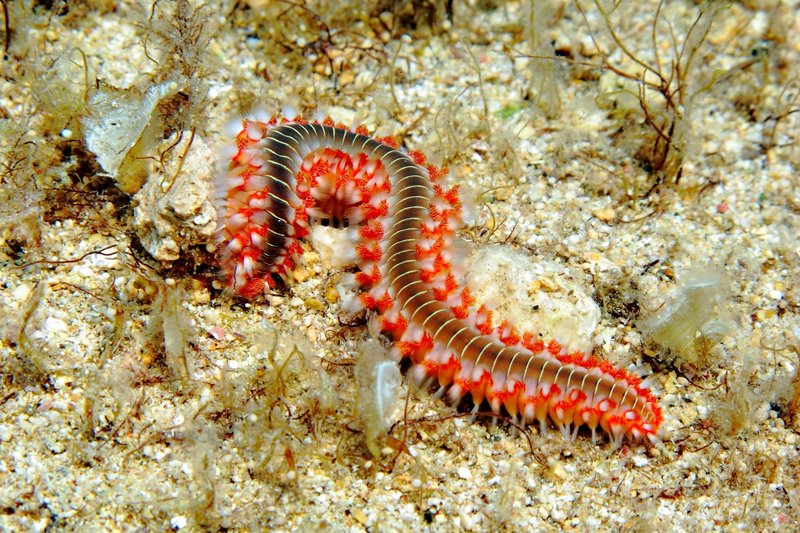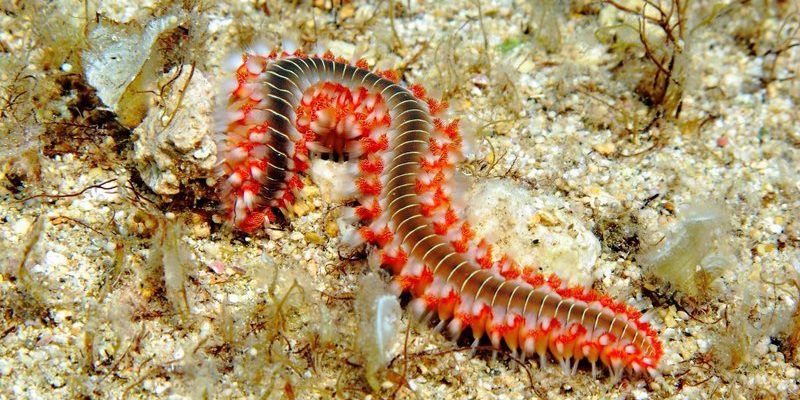
However, before you decide to introduce bristle worms into your aquarium, it’s essential to weigh the benefits against the drawbacks. Are they truly the helpful companions they seem, or can they bring hidden challenges? Let’s dive in and explore everything you need to know about keeping bristle worms.
What are Bristle Worms?
Bristle worms are segmented worms belonging to the polychaete class. You can find them in various marine environments, usually burrowed in the sand or mud. They have a long, worm-like body covered with tiny bristles, which give them their name. You might see them wriggling around your tank, scavenging for leftover food or even dead organic matter. This behavior is handy because it helps prevent waste buildup in your aquarium.
There are many types of bristle worms, but the most common ones in aquariums are the *Eunice* and *Hermodice* species. While they come in various colors and sizes, many aquarists appreciate their role in maintaining a healthy tank. However, some species can grow quite large, so you’ll want to be mindful of what you’re introducing into your aquatic space.
Benefits of Keeping Bristle Worms
Keeping bristle worms in your aquarium can offer several advantages. Here are a few key reasons why you might want to consider adding them to your tank:
- Natural Cleaners: Bristle worms are scavengers at heart. They help break down leftover food and detritus that can pollute your tank, keeping the environment clean and balanced.
- Oxygenation of Substrate: By burrowing into the substrate, bristle worms help aerate it, allowing better water circulation. This process can benefit beneficial bacteria that thrive in your tank.
- Food Source for Other Creatures: If you’re keeping fish or reef inhabitants, bristle worms can serve as a natural food source. Some fish love to snack on them, adding another layer of interaction in your aquarium.
These benefits make bristle worms a welcome addition to many aquarists. They provide ecological benefits that can lead to a healthier environment for your fish and corals.
Drawbacks of Keeping Bristle Worms
While bristle worms have their perks, there are some downsides to consider. It’s essential to approach this addition to your tank with caution. Here are some potential drawbacks:
- Overpopulation: Bristle worms can reproduce rapidly in a favorable environment. If you introduce too many, or if they have an abundance of food, you might find your tank overcrowded with these critters.
- Damage to Corals: Some larger species of bristle worms can become opportunistic feeders. They may snack on coral tissue if food sources are scarce, which can lead to stress or damage to your precious corals.
- Stinging Bristles: The bristles on their bodies can cause skin irritation if handled. They are not dangerous but can lead to an itchy or burning sensation if you accidentally touch one during maintenance.
These drawbacks shouldn’t deter you completely from keeping bristle worms, but they certainly warrant careful consideration.
How to Add Bristle Worms to Your Aquarium
If you decide to welcome bristle worms into your tank, you’ll want to do so thoughtfully. Here’s a step-by-step guide on how to get started:
1. Choose the Right Species: First, choose a species suitable for your tank size and other inhabitants. Smaller varieties are usually safer for reef tanks.
2. Check Your Water Parameters: Ensure your water quality and parameters are suitable for bristle worms, including temperature, salinity, and pH levels.
3. Introduce Gradually: Start with a small number and monitor the population. This approach allows you to gauge how they affect your ecosystem without overwhelming your tank.
4. Provide Food: While they help clean up detritus, you can also feed them occasionally with sinking pellets or other appropriate foods to keep them healthy and thriving.
By following these steps, you can create a welcoming environment for your bristle worms.
Maintaining a Balance with Bristle Worms
Keeping bristle worms is all about balance. Here are some tips to ensure they don’t become a nuisance while still contributing to your tank’s ecosystem:
- Regular Maintenance: Perform regular tank maintenance, including cleaning and vacuuming the substrate. This helps control their population without entirely removing their benefits.
- Monitor Water Quality: Keep an eye on ammonia and nitrate levels, as high levels can lead to an explosion in their population. Regular water changes can help.
- Observe Behavior: Watch how bristle worms interact with other creatures in your tank. If you notice any signs of stress in your corals or fish, it might be time to reassess their presence.
These practices can help maintain your aquarium’s balance while enjoying the benefits bristle worms bring.
Alternatives to Bristle Worms
If you’re unsure about keeping bristle worms, there are alternatives that can help maintain a healthy aquarium. Here are a few options:
- Hermit Crabs: These little scavengers are great for cleaning up leftover food and detritus without the potential risks associated with bristle worms.
- Clean-Up Crew: Many aquarists employ a combination of snails (like turbo snails) and shrimp to help keep the tank clean. These creatures can perform similar cleaning functions without the drawbacks of bristle worms.
- Regular Fish Feeding: If you maintain a stable fish population that consumes leftover food, you can minimize waste without needing bristle worms for cleanup.
Each alternative has its benefits, and you can choose which one best fits your aquarium setup and philosophy.
Bristle worms can be a somewhat divisive topic in the aquarium community, and it’s easy to see why. They bring several benefits that can enhance your tank’s health, acting as natural cleaners and providing a food source for other fish. However, with these advantages come potential drawbacks like overpopulation and possible harm to corals.
Ultimately, the decision to keep bristle worms should be made after careful consideration of your tank setup, the inhabitants, and your maintenance routine. As long as you monitor their population and maintain balance in your aquarium, these little creatures can play a crucial role in creating a thriving underwater environment. So, whether you choose to embrace bristle worms or look for alternatives, knowing your options will surely lead you to an aquarium that’s both beautiful and balanced.

